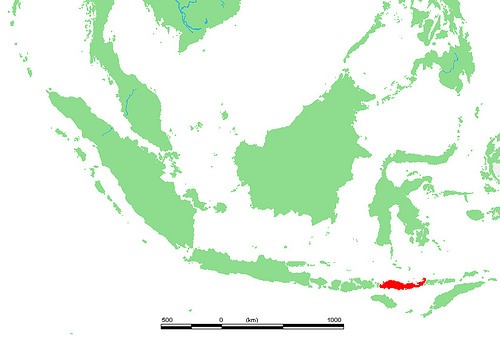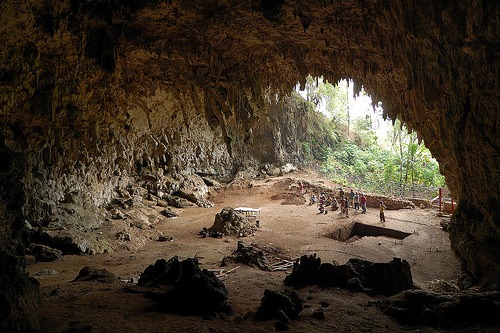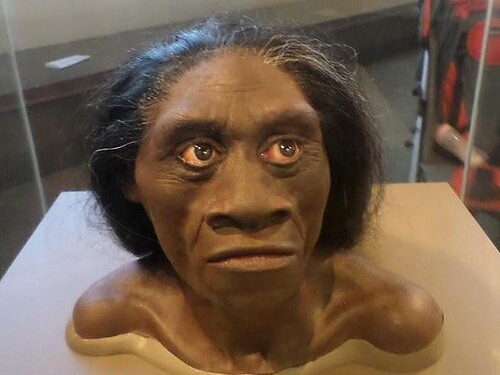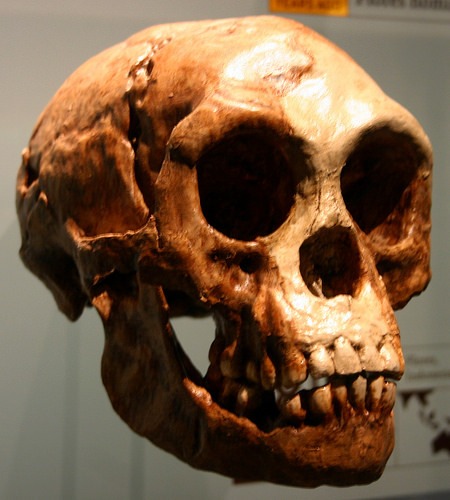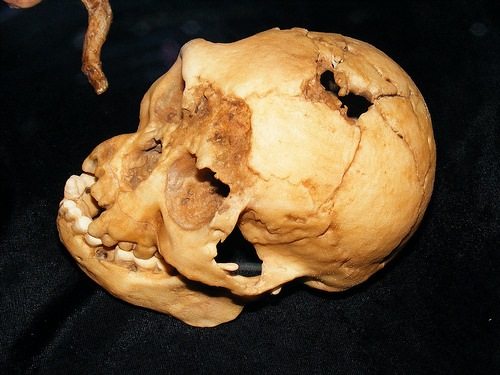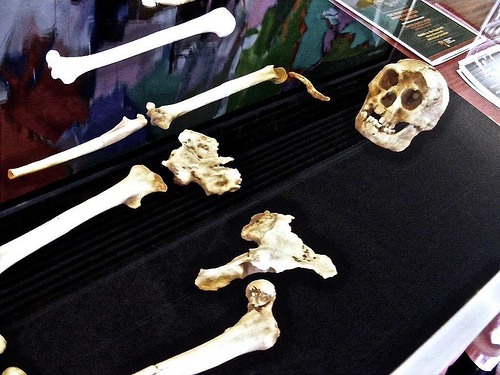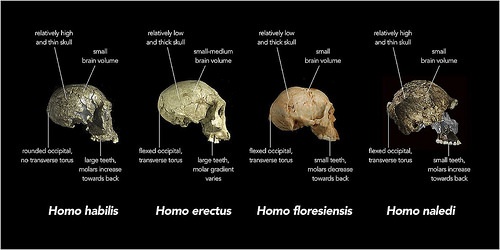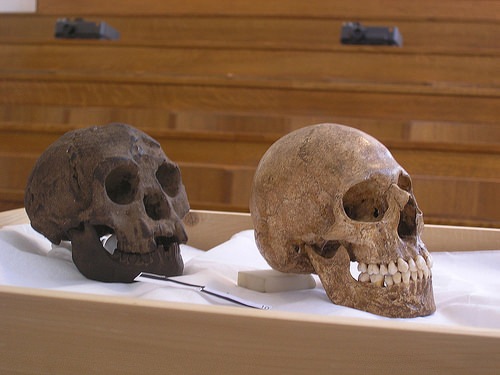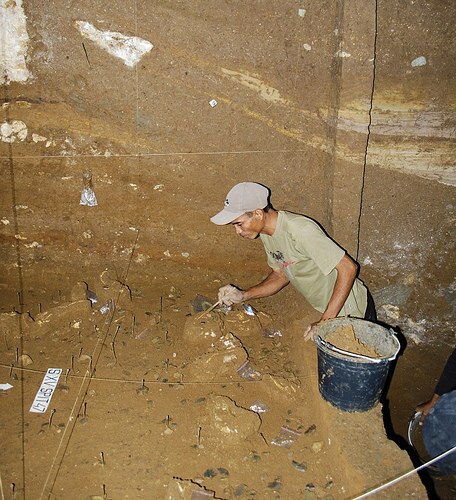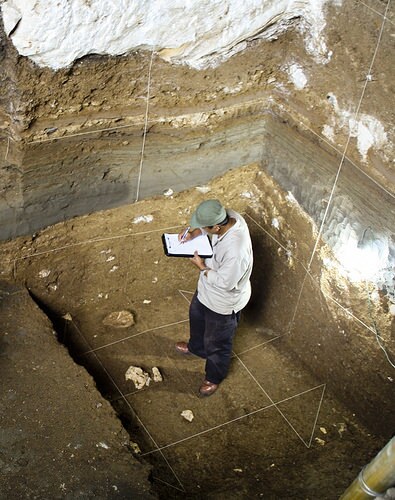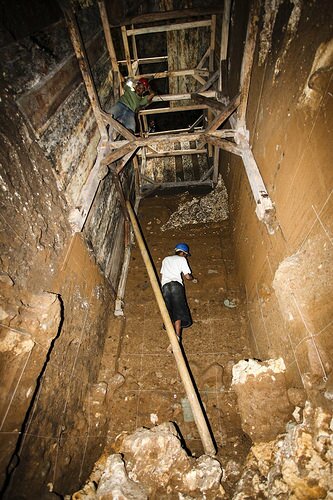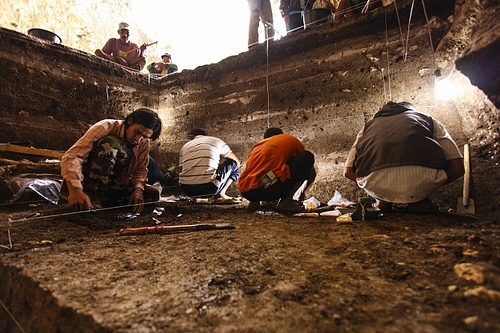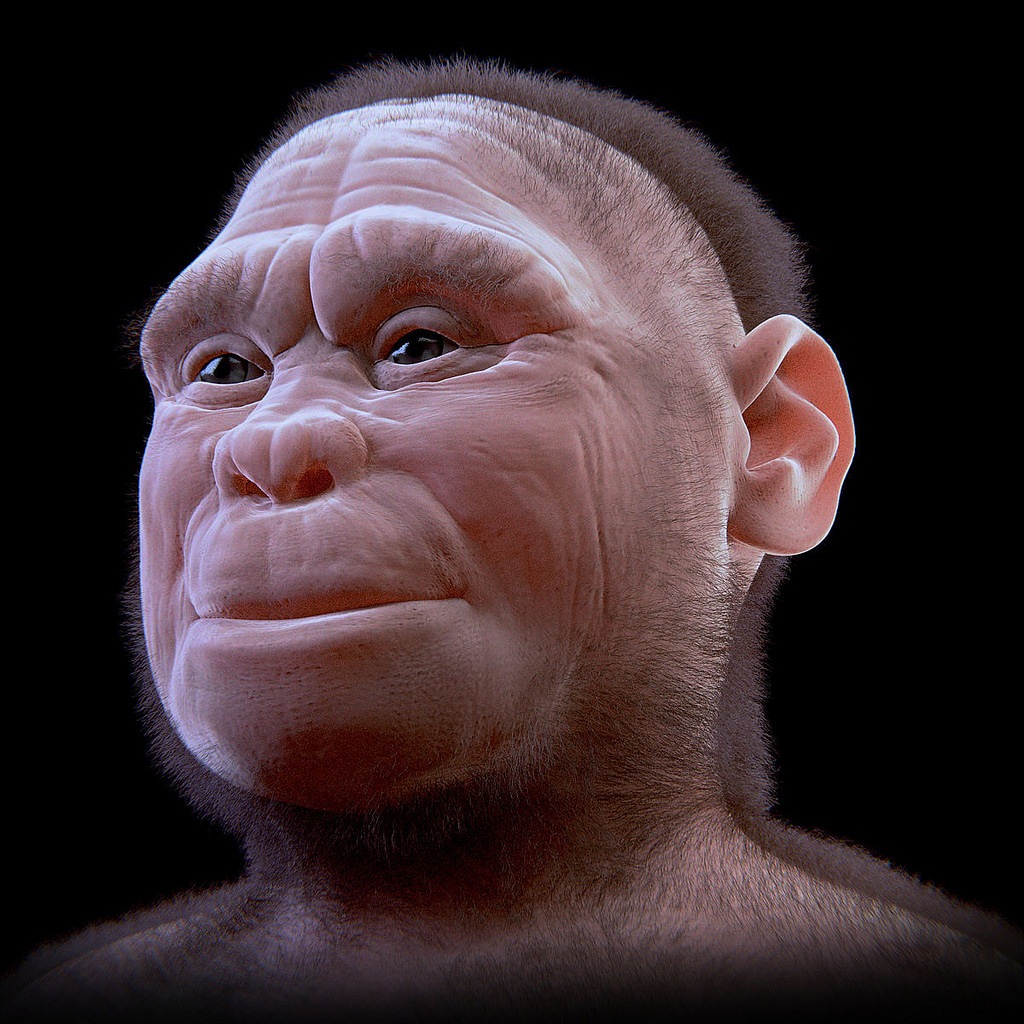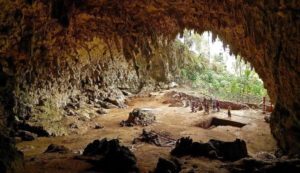
She stares at me from across a chasm of more than seventy thousand years, long dark hair swirling about her head, eyes wide open, alert, piercing, as if she was searching. Her skin is dark brown, deeply lined from years of exposure to the tropical sun. Her face short and broad, with a small forehead, heavy brow ridge, and prominent jaw. She looks much like us in some ways, and yet very different in others.
I’m at the David H. Koch Hall of Human Origins exhibit of the Smithsonian Institution’s National Museum of Natural History, viewing a reconstruction of the type specimen called Homo floresiensis, the enigmatic “Little Lady of Flores” whose discovery has challenged our notions of what it means to be human.
According to the scientists who have examined her skeletal remnants, she was probably about thirty years old when she died. Her remains (referred to by scientists as ‘LB1’) were unearthed by a team of Indonesian and Australian researchers in 2003 within a cave called Liang Bua on the Island of Flores in Indonesia.
Three things made her discovery particularly sensational. First was her diminutive stature. In life she stood about three feet six inches tall, roughly the size of a modern-day five-year-old. Second was the suite of primitive skeletal characters that marked her as a member of an archaic human species. Third was the comparatively young geological age of her remains, which made LB1 and her kind contemporaries of our own species, Homo sapiens. The final installment of Peter Jackson’s cinematic adaptation of the Lord of the Rings trilogy had been released the year before the discovery of her remains, so perhaps it was inevitable that the new species would be dubbed “hobbits.” But the discovery ignited a firestorm of controversy, which continues to this day.
____________________________________________
The Island of Flores, indicated in red, within the context of Indonesia. Wikimedia Commons
__________________________________________________________
Liang Bua, showing excavations underway within. Rosino, Wikimedia Commons
_________________________________________________________
The reconstructed face of the “Little Lady of Flores”, as displayed in the David H. Koch Hall of Human Origins at the Smithsonian Institution’s National Museum of Natural History.
___________________________________________
A New Species?
In addition to the partial skeleton of LB1, archaeologists found remains of eight other individuals with similar anatomy and stature at Liang Bua, but no other skulls. They also found numerous stone tools, similar to those made by other hominins, as well as the remains of Komodo dragons, vultures, giant marabou storks, giant rats, and dwarf elephants. The cave appears to have been occupied by Homo floresiensis at least as far back as 190,000 years ago.
One of the characteristic attributes of LB1 is her height, or more precisely, her lack of it. Even modern-day pygmies would tower over her, by a foot or more – although, interestingly, she had about the same body mass. Thus, she was much shorter yet generally more robust than a modern-day pygmy.
The size of her brain is also peculiar. The brain of modern humans averages about 1500 cubic centimeters, but at 417 cc, her brain measures little more than a third of that volume. This would be considered ‘off the charts’ for modern humans, Neandertals, and even for Homo erectus, an extinct human ancestor whose earliest representatives lived as far back as nearly 2 million years ago. In fact, it’s barely at the bottom of the volume size range for Australopithecus, an extinct hominin that existed as early as over 4 million years ago in Africa.
It’s thus no surprise that her discovery was greeted with skepticism by many scholars. Some have argued, for example, that LB1 was simply a modern human with microcephaly. There is a long-standing precedent for this sort of thing. At one time or another, Neandertal Man, Java Man (Homo erectus), and Australopithecus were all dismissed as nothing more than modern humans with some pathology or another. But these doubts have been put to rest. Morphometric analysis has shown the form of the Homo floresiensis skull to be completely outside the range of variation for modern humans, including modern-day pygmies and modern-day microcephalics. On the other hand, it is well within the range of archaic human species, and more comparable to that of Homo erectus and other early Homo species.
Since then, a variety of other conditions have been posited to account for LB1’s dwarfed body and brain, including Down Syndrome, Laron Syndrome, and congenital hypothyroidism. None of these explanations have proven to be adequate. A recent study by an international team of researchers led by Karen Baab of Midwestern University, for example, has convincingly shown that LB1 did not have Down Syndrome, and that its morphology was much more consistent with the types of features observed in the fossilized remains of archaic humans. And though there are hundreds of other genetic syndromes known to result in reduced body and brain size, not one of them is known to result in any of the primitive skeletal features displayed by LB1 and her kind. Moreover, the Flores hominins survived there for (at least) tens of thousands of years, making it inconceivable that they all had some kind of devastating hereditary disease. An analysis published last February in the Journal of Human Evolution confirms this. According to that study, the Liang Bua skull displays no evidence of pathology, nor any of the evolutionary novelties that distinguish our species from other early humans, like Homo erectus. In other words, this is the real deal: a bona fide, distinct species, in some ways radically different from us and yet recognizably human — and given the dating, apparently existing contemporaneously in time with our own species for tens of thousands of years.
_____________________________________________
Above: The skull of Homo floresiensis. Above image by Ryan Somma, Wikimedia Commons. Below image by Ray, Wikimedia Commons
___________________________________________________________
________________________________________________________
An assemblage of the excavated remains of Homo floresiensis as displayed. Ray, Wikimedia Commons
______________________________________________
The Homo floresiensis skull as it compares to those of other well-known hominins of the fossil record. Chris Stringer, Wikimedia Commons
______________________________________________
The Homo floresiensis skull (left) compared to a skull of a modern human encephalized skull. Avandergeer, Wikimedia Commons
________________________________________________________________
Seeking Answers
This leaves us with some questions.
First: Why were the Flores hominins so small?
Their discoverers proposed this was due to a well-known phenomenon known as ‘island dwarfism’, which is to say that animals living in isolation in island habitats become smaller over generations, perhaps due to limited food supply. Or perhaps due to group selection for a larger population size – obviously, a habitat of a given size can support a greater population of small individuals than large ones – hence such occurrences as dwarf elephants. Matt Tocheri, one of the lead authors of the Nature paper, is Canada Research Chair in Human Origins at Lakehead University in Canada and a Research Associate in the Smithsonian Institution’s Human Origins Program. In an interview, he indicated there isn’t any direct evidence for the island dwarfism theory – the ancestors of the Flores hominins may well have been small-bodied to begin with. Homo erectus, a presumed ancestor of Homo floresiensis (and our own species, as well) was about as tall as we are, but researchers have found other archaic species of Homo that were smaller. “Until we find fossils on Flores that show us what that ancestral group looked like, we really can’t answer the question definitively,” he said.
Another question: How did the ancestors of the Flores hominins get there in the first place?
Stone tools dating back from over one million years ago have been recovered from Flores. Were the people that made these old tools the ancestors of Homo floresiensis? New findings now suggest that there may have been an ancient ancestral population (see supplement below)*. Flores is an oceanic island – it has never been connected to the mainland. Were ancient mariners building rafts a million years ago? It’s not unthinkable, but an alternative explanation is that the ancestors of LB1 and her kind got there by means of a floating island – a knot of coastal vegetation, intertwined at the roots, torn loose by a typhoon or maybe even a tsunami. We may imagine the dazed survivors stumbling ashore at Flores, unwitting subjects of a great evolutionary experiment, a never-to-be-repeated event in the history of life on earth. If all this sounds improbable, it should. However they got there, we have to assume that the island of Flores was reachable by early hominins, but just barely so.
In any case, this isolation is presumably why the Flores hominins were able to persist for millennia, without being either slaughtered by or subsumed into mainland populations.
This leads us to yet another question: What happened to them? What made them extinct?
Originally, investigators believed that the youngest fossils dated from as recently as 12,000 years ago, but in March, 2016, a paper published in Nature has suggested the conclusion that the most recent remains come from strata dated to more than 50,000 years before present. More specifically, the paper relates, LB1 herself lived and died at least 72,000 years ago based on directly dating her bones using uranium-series methods.
I asked Dr. Tocheri what happened to the Flores hominins.
“That’s a huge question,” he replies. He notes that modern humans, perhaps one reason why the Flores hominins disappeared, had reached Australia by 50,000 years ago. He goes on to note that it’s not just Homo floresiensis who vanished from Liang Bua around 50,000 years ago. The Komodo dragons, giant storks, and the dwarf elephants disappeared from Liang Bua at the same time. Influence from modern humans? “The timing is certainly suspicious,” he adds, but he explains that we still don’t know whether the Flores hominins ever encountered modern humans at all. The youngest Homo floresiensis remains date to about 60,000 years ago and stone tools suggest this species persisted until about 50,000 years ago, but the oldest modern human remains on Flores (also from Liang Bua) are only 11,000 years old (although a recently published study** and the discovery of two modern human teeth*** suggests that modern humans likely occupied Liang Bua at least 41,000 – 46,000 years ago.) We simply don’t know with certainty what happened in the intervening 40,000 years. We don’t know whether modern humans played a role in the extinction of Homo floresiensis, or if they did, what role they played. They might have massacred the Flores hominins, or caused their extinction unintentionally, through indirect competition or massive ecosystem disruptions.
Or perhaps the Flores hominins never went extinct at all. To this day, some islanders tell of miniature humans, sounding suspiciously like LB1 and her kind, which they call Ebu Gogo, or the Grandmother Who Eats Everything. I asked Dr. Tocheri what the chances are that Ebu Gogo is still out there, roaming the jungles of Flores. He lets out a hearty laugh and replies, “I don’t think so. I would love to be proven wrong, but the evidence for that is pretty slim, especially now that we know Homo floresiensis disappeared by at least 50,000 years ago. It was a little bit different when there was talk about Homo floresiensis persisting until maybe about 12,000 years ago, but even 12,000 years is a long time ago.” He notes that similar folk tales of little people are widespread among various cultures of the mainland and islands in southeast Asia, not just the present-day inhabitants of Flores. “The Ebu Gogo stories are interesting, but I don’t think they have anything to do with Homo floresiensis.”
Looking to the Future
Homo floresiensis may be long gone, but the questions raised by their discovery continue to fascinate researchers. “We’ll continue excavating every year,” Dr. Tocheri tells me. “We’re continuing at Liang Bua and in fact we just finished our excavations for this year in early March [2016]. We’re also surveying the surrounding region for other sites that might help answer some of these important questions about when and how and why Homo floresiensis and these other taxa disappear and possibly go extinct, and when modern humans actually arrived on the scene, and what impact their arrival had. I’m sure we’ll be investigating at Liang Bua and the surrounding area for many years to come.”
And the wider significance of all this?
“Knowing that we shared this planet with not only species like Neandertals and Denisovans, which we’re clearly much more closely related to, but with something like Homo floresiensis, is really quite extraordinary,” he says. “Before the discovery of Homo floresiensis, we didn’t see that type of hominin in the fossil record after about one million years ago at the latest, so to see that there was a lineage descending from some of those hominins that persisted up until the time we evolved is really quite extraordinary. I see it as a reminder of how much diversity within our human family has been lost over the past million years.”
For Tocheri and other scientists, though many questions still remain, the Flores discoveries have nonetheless excited the imagination.
“You know, chimpanzees can look across the Congo River [in Africa] and see bonobos on the other side,” says Tocheri. “And yet their respective lineages have been separated for about one to two million years. They can recognize each other obviously as chimps, but they’re clearly different species. And we as modern humans living today, we no longer have that, but Homo floresiensis reminds us that what is true for chimps today may have also been true for us as recently as 50,000 years ago, when Homo floresiensis was still surviving on this isolated island.”
—————————————————————
Article Amending Supplement
*An ancestral species found?
Only hours before this article was published, news broke worldwide of the discovery of fossil remains of hominins that are similar in size but at least ten times older at the site of Mata Menge, about 70 km east of Liang Bua in an open grassland area. Led by archaeologist Dr Adam Brumm from Griffith’s Research Centre of Human Evolution, the team uncovered a fragment of a hominin lower jaw and several isolated teeth. They were removed from a layer of sandstone which had formed from an ancient deposit laid down by a lakeside stream about 700,000 years ago. The context of the new finds thus date them to as much as 700,000 years ago.
But this was not all they discovered.
“We have unearthed fossils from at least three individuals, including two children, along with stone tools that are almost identical to those made by the much younger Homo floresiensis,” said Brumm, who began work at the site with colleagues from the Geology Museum and Geological Survey Institute in Bandung, Indonesia. “There is a striking similarity in size and form between the Mata Menge hominins and the Liang Bua ‘hobbit’, which is surprising given the former are at least several hundred millennia older. This suggests the Mata Menge individuals belonged to a population of ancient hobbit-like hominins that gave rise to Homo floresiensis. They may even have been a very early form of ‘hobbits’, which would mean this species existed for far longer than anyone had anticipated.”
The new finds are significant in light of two prevailing hypotheses. The first suggests that the Flores hominins are descendants of the Asian Homo erectus, (popularly known as ‘Java Man’), which was an early hominin that had eventually dispersed to the island of Java (west of Flores) about 1.5 million years ago. This hominin was comparable in physical stature to modern humans, but with a much more archaic morphology, particularly in the skull. Scientists theorize that a small branch or group of these hominins may have become isolated on Flores and then, over time, reduced in body size due to a natural phenomenon known as ‘island dwarfism’.
A second theory proposes that the Flores hominins stem from an even more ancient species, such as Homo habilis or perhaps Australopithecus. These species of hominin are already well known from the African fossil record.
One interpretation of the new finds favors the former theory.
“While only a handful of fossils has been found at Mata Menge so far, characteristic features of the teeth strongly imply an ancestral relationship with Homo erectus,” Brumm said. “This lends weight to the theory that the ‘hobbit’ was a dwarfed version of the famous Java Man, which somehow got marooned on the island. The fact that they were found with fossils of extinct pygmy elephants (Stegodon) and giant rats also supports the idea of an isolated group of Homo erectus undergoing a dramatic evolutionary change owing to the Island Rule.”
Another study, conducted by Dr Debbie Argue and colleagues of the Australian National University (ANU), however, found that Homo floresiensis was most likely a sister species of Homo habilis—one of the earliest known species of early humans dated to about 1.75 years ago and found in Africa. The study involved analyzing 133 data points from the skull, jaws, teeth, arms, legs and shoulders. Professor Mike Lee of Flinders University and the South Australian Museum used statistical modeling to analyze the data.
“When we did the analysis there was really clear support for the relationship with Homo habilis. Homo floresiensis occupied a very primitive position on the human evolutionary tree,” Professor Lee said. “We can be 99 per cent sure it’s not related to Homo erectus and nearly 100 per cent chance it isn’t a malformed Homo sapiens.”
More work remains to be done in the search for additional fossils at Mata Menge and other sites, however, before conclusions can be drawn.
“Mata Menge is a goldmine,” says Brumm. “I expect that further excavations at this site will eventually yield a hominin skull, which will finally allow us to put a face and a name to the ‘hobbit’s ancestor. Then we will know how this experiment in human evolution got started”.
—D.M., adapted and edited from the subject Griffith University press release and the Australian National University press release.
———————————————————————————-
** A recent study led by Dr. Mike Morley of Wollongong University and published in the Journal of Archaeological Science on June 30, 2016, suggests that modern humans inhabited the Liang Bua cave at least 41,000 years ago. This investigation uncovered ancient fireplaces created and used between 41,000 and 24,000 years ago within the cave. Morley suggests that modern humans were the likely fire makers as no evidence has been found thus far pointing to fire use by Homo floresiensis during their recorded 130,000 years of occupation of the site.
*** “Human remains found in hobbit cave,” Nature doi:10.1038/nature.2016.20656
———————————————————————————–
Archaeological excavations of Late Pleistocene deposits at Liang Bua in progress. The sediments shown being excavated are between 100 and 60 thousand years old and contain skeletal and behavioral evidence of Homo floresiensis. Eight years of further excavations and study at the Indonesian cave site of Liang Bua have pushed back the time of disappearance of the ‘hobbits’ of Flores (Homo floresiensis) from as recently as 12,000 years ago to about 50,000 years ago—around the same time that modern humans (Homo sapiens) first dispersed through the wider region and reached Australia, according to new findings published in the journal Nature. Courtesy Smithsonian Institution National Museum of Natural History News Room. Photo credit: Liang Bua team
________________________________________________________
Thomas Sutikna, lead author of the new study and an archaeologist from the University of Wollongong in Australia and the National Research Centre for Archaeology in Indonesia, is shown documenting the stratigraphic details of multiple volcanic layers. The thick grayish layer represents a massive eruption dated to about 50 thousand years ago. This tephra sits directly on top of the sedimentary deposits that contain skeletal and behavioral evidence of Homo floresiensis. Courtesy Smithsonian Institution National Museum of Natural History News Room. Photo credit: Liang Bua team
_________________________________________________________
Archaeological excavations at Liang Bua can reach depths of more than 8 meters, as shown in this photo. Courtesy Smithsonian Institution National Museum of Natural History News Room. Photo credit: Liang Bua team
________________________________________
Archaeological excavations of Holocene deposits at Liang Bua in progress. These sediments contain skeletal and behavioral evidence of modern humans (Homo sapiens). Courtesy Smithsonian Institution National Museum of Natural History News Room. Photo credit: Liang Bua team
_____________________________________________________
The reconstructed face of Homo floresiensis. Cicero Moraes et alii, wikimedia Commons
________________________________________
List of Sources
1. Brown, P. et al. 2004. A new small-bodied hominin from the Island of Flores, Indonesia.
Nature 431:1055-1061.
2. Morwood, M.J. et al. 2004. Archaeology and age of a new hominin from Flores in eastern
Indonesia. Nature 431:1087-1091.
3. Diamond, J. The astonishing micropygmies. Science 306:2047-2048.
4. Falk, D. et al. 2005. The brain of LB1, Homo floresiensis. Science 308:242-205.
5. Weber, J. et al. 2005. Comment on “The brain of LB1, Homo floresiensis.” Science 310:236b.
6. Falk, D. et al. 2005. Response to “Comment on ‘The brain of LB1, Homo floresiensis.’”
Science 310:236.
7. Culotta, E. 2006. How the hobbit shrugged: Tiny hominids story takes new turn. Science
312:983-984.
8. Martin, et al. 2006. Comment on “The brain of LB1, Homo floresiensis.” Science 312:999b.
9. Falk, D. et al. 2006. Response to “Comment on ‘The brain of LB1, Homo floresiensis.’”
Science 312:999.
10. Culotta, E. 2006. Tools link Indonesian “hobbits” to earlier Homo ancestor. Science
312:1293.
11. Culotta, E. 2006. Skeptics seek to slay the “hobbit,” calling Flores skeleton a modern human.
Science 313:1028-1029.
12. Jacob, T. et al. 2006. Pygmoid Austromelanesian Homo sapiens skeletal remains from Liang
Bua, Flores: Population affinities and pathological abnormalities. PNAS 103:13421-13426.
13. Argue, D. et al. 2006. Homo floresiensis: Microcephalic, Pygmoid, Australopithecus, or
Homo? Journal of Human Evolution 51:360-374.
14. Tocheri, M. et al. 2007. The primitive wrist of Homo floresiensis and its implications for
hominin evolution. Science 317:1743-1745.
15. Falk, D. et al. 2007. Brain shape in human microcephalics and Homo floresiensis. PNAS
104:20513-20518.
16. Hershkovitz, I. et al. 2007. Comparative skeletal features between Homo floresiensis and
patients with primary growth hormone insensitivity (Laron syndrome). American Journal of Physical Anthropology 134:198-298.
17. Moore, M.W. and A. Brumm 2007. Stone artifacts in island Southeast Asia: New insights
from Flores, Indonesia. Journal of Human Evolution 52:85-102.
18. Larson, S.G. et al. 2007. Homo floresiensis and the evolution of the human shoulder. Journal
of Human Evolution 52:718-731.
19. Obendorf, P.J. et al. 2008. Are the small human-like fossils found on Flores human endemic
cretins? Proceedings of the Royal Society B 275:1287-1296.
20. Holliday, T.W. and R.G. Franciscus 2008. Body size and its consequences: Allometry and
the lower limb length of Liang Bua 1 (Homo floresiensis). Journal of Human Evolution 57:223-228.
21. Zhu, R.X. et al. 2008. Early evidence of the genus Homo in East Asia. Journal of Human
Evolution 55:1075-1085.
22. Lyras, G.A. et al. 2009. The origin of Homo floresiensis and its relation to evolutionary
processes under isolation. Anthropological Science 117:33-43.
23. Jungers, W. and K. Baab 2009. The geometry of hobbits: Homo floresiensis and human
evolution. Significance 6:159-164.
24. Morwood, M.J. et al. 2009. Preface: research at Liang Bua, Flores, Indonesia. Journal of
Human Evolution 57:437-449.
25. Westaway, K.E. et al. 2009. The evolving landscape and climate of western Flores: an
environmental context for the archaeological site of Liang Bua. Journal of Human Evolution 57:450-464.
26. Westaway, K.E. et al. 2009. Reconstructing the geomorphic history of Liang Bua, Flores,
Indonesia: A stratigraphic interpretation of the occupational environment. Journal of Human Evolution 57:465-483.
27. Roberts, R.G. et al. 2009. Geochronology of cave deposits at Liang Bua and of adjacent river
terraces in the Wae Racang Valley, western Flores, Indonesia: A synthesis of age estimates for the type locality of Homo floresiensis. Journal of Human Evolution 57:484-502.
28. Moore, M.W. et al. 2009. Continuities in stone flaking technology at Liang Bua, Flores,
Indonesia. Journal of Human Evolution 57:503-526.
29. Van den Bergh, G.D. et al. 2009. The Liang Bua faunal remains: a 95 k.yr. sequence from
Flores, East Indonesia. Journal of Human Evolution 57:527-537.
30. Jungers, W.L. et al. 2009.Descriptions of the lower limb skeleton of Homo floresiensis.
Journal of Human Evolution 57:538-554.
31. Larson, S.G. et al. 2009. Descriptions of the upper limb skeleton of Homo floresiensis.
Journal of Human Evolution 57:555-570.
32. Brown, P. and T. Makeda 2009. Liang Bua Homo floresiensis mandibles and mandibular
teeth: A contribution to the comparative morphology of a new hominin species. Journal of Human Evolution 57:571-596.
33. Falk, D. et al. 2009. LB1’s virtual endocast, microcephaly, and hominin brain evolution.
Journal of Human Evolution 57:597-607.
34. Baab, K. and K.P. McNulty 2009. Size, shape, and asymmetry in fossil hominins: The status
of LB1 cranium based on 3D morphometric analysis. Journal of Human Evolution 57:608-622.
35. Morwood, M.J. and W.L. Jungers 2009. Conclusions: Implications of the Liang Bua
excavations for hominin evolution and biogeography. Journal of Human Evolution 57:640-648.
36. Groves, C. and C. Fitzgerald 2010. Healthy hobbits or victims of Sauron. Journal of
Comparative Human Biology 61:211.
37. Trueman, J. 2010. A new cladistics analysis of Homo floresiensis. Journal of Human
Evolution 59:223-226.
38. Kaifu, Y. et al. 2011. Craniofacial morphology of Homo floresiensis: Description, taxonomic
affinities, and evolutionary implications. Journal of Human Evolution 61:644-682.
39. Gannon, M. 2012. Real-life “hobbit” face revealed.
40. Brown, P. 2012. LB1 and LB6 are not modern Homo sapiens cretins. Journal of Human
Evolution 62:201-224.
41. Orr, C.M. et al. 2013. New wrist bones of Homo floresiensis from Liang Bua (Flores,
Indonesia). Journal of Human Evolution 64:109-129.
42. Montgomery, S.H. 2013. Primate brains, the “island rule,” and the evolution of Homo
floresiensis. Journal of Human Evolution 63:750-760.
43. Daegling, D.J. et al. 2014. Geometric properties and comparative biomechanics of Homo
floresiensis mandibles. Journal of Human Evolution 68:36-46.
44. Balzeau A. and P. Charlier 2016. What do the cranial bones of LB1 tell us about Homo
floresiensis? Journal of Human Evolution 93:12-24.
45. Sutikna, T. et al. 2016. Revised stratigraphy and chronology for Homo floresiensis at Liang
Bua in Indonesia. Nature (2016) doi:10.1038/nature17179.
46. Karen L. Baab, Peter Brown, Dean Falk, Joan T. Richtsmeier, Charles F. Hildebolt, Kirk Smith, William Jungers. (2016) A Critical Evaluation of the Down Syndrome Diagnosis for LB1, Type Specimen of Homo floresiensis. PLOS ONE.
47. Morley, M.W., et al., Initial micromorphological results from Liang Bua, Flores (Indonesia): Site formation processes and hominin activities at the type locality of Homo floresiensis, Journal of Archaeological Science (2016), http:// dx.doi.org/10.1016/j.jas.2016.06.004
_________________________________________________________

